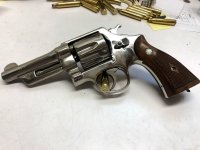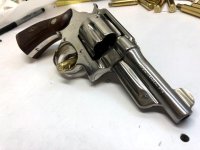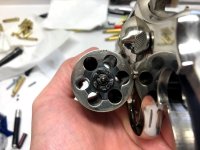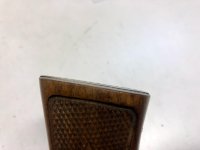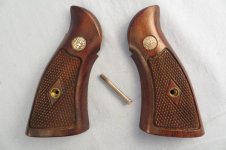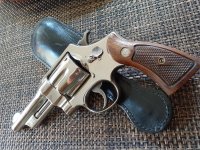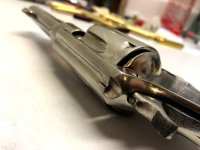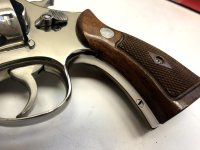smithra_66
Member
- Joined
- Jan 6, 2020
- Messages
- 1,307
- Reaction score
- 2,140
Hi all,
A few months back I picked up this pretty nice 38/44 HD and I had a couple questions....
I looked into the background on this and I found that it's an early 1946 transitional model...still has the long action but it is stamped with an "S" in the serial number to denote that it has the new, simpler hammer block safety that is levered to the rebound slide.
This one also has the "*" stamp on it, denoting that it made a trip back to the factory, and on the grip frame it is stamped "1080." I'm assuming that means it was back in October of 1980 for service, probably a refinish. It also thankfully has the "N" stamped on the frame, meaning it is a factory nickel gun. Does anyone know what those "A's" mean? See pictures.
Unfortunately, this one also seems to have reamed chambers because 357 cases seat fine. Does anyone know if S&W actually would have done this when it was back in the shop in 1980 or was this strictly an aftermarket thing back then? What's the general consensus on shooting magnums out of it? I know the gun itself is plenty strong (it's an absolute tank), but are there any risks from shooting 357 magnum in it? In my older guns, I run lead bullets and modest charges of Unique, so we're probably talking more about 38 spl +P pressures here, not 357 magnum level.
One more question: It came wearing rubber stocks (I'm betting that's one reason it was pretty cheap, under $550 if memory serves me). I quickly replaced them with some proper diamond magnas. These magnas seem to be of the older variety because the inner metal is blued instead of silver, but they still are about 1/64" short. They fit flush on my other (more recent) N frames. Was the grip frame longer in this era?
This one is a great shooter. The single action is under 2 lbs and the double action is nice and light too. Not sure if they came this way back then or not, because when I examined the internals they don't seem like an action job was performed. Good stuff either way....I was able to get it to skip if I did a Jerry Miculek rapid fire on it....I'm assuming these big 38 N frames, especially with nickel coating, are prone to that with such massive amounts of material in the cylinder. The gun seems in fine mechanical order and if I shoot at a normal speed all is fine...I won't try to shoot it that fast again that's for sure!
Thanks for the help in advance!
A few months back I picked up this pretty nice 38/44 HD and I had a couple questions....
I looked into the background on this and I found that it's an early 1946 transitional model...still has the long action but it is stamped with an "S" in the serial number to denote that it has the new, simpler hammer block safety that is levered to the rebound slide.
This one also has the "*" stamp on it, denoting that it made a trip back to the factory, and on the grip frame it is stamped "1080." I'm assuming that means it was back in October of 1980 for service, probably a refinish. It also thankfully has the "N" stamped on the frame, meaning it is a factory nickel gun. Does anyone know what those "A's" mean? See pictures.
Unfortunately, this one also seems to have reamed chambers because 357 cases seat fine. Does anyone know if S&W actually would have done this when it was back in the shop in 1980 or was this strictly an aftermarket thing back then? What's the general consensus on shooting magnums out of it? I know the gun itself is plenty strong (it's an absolute tank), but are there any risks from shooting 357 magnum in it? In my older guns, I run lead bullets and modest charges of Unique, so we're probably talking more about 38 spl +P pressures here, not 357 magnum level.
One more question: It came wearing rubber stocks (I'm betting that's one reason it was pretty cheap, under $550 if memory serves me). I quickly replaced them with some proper diamond magnas. These magnas seem to be of the older variety because the inner metal is blued instead of silver, but they still are about 1/64" short. They fit flush on my other (more recent) N frames. Was the grip frame longer in this era?
This one is a great shooter. The single action is under 2 lbs and the double action is nice and light too. Not sure if they came this way back then or not, because when I examined the internals they don't seem like an action job was performed. Good stuff either way....I was able to get it to skip if I did a Jerry Miculek rapid fire on it....I'm assuming these big 38 N frames, especially with nickel coating, are prone to that with such massive amounts of material in the cylinder. The gun seems in fine mechanical order and if I shoot at a normal speed all is fine...I won't try to shoot it that fast again that's for sure!
Thanks for the help in advance!
Attachments
Last edited:

